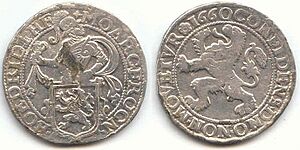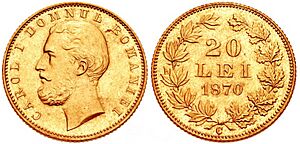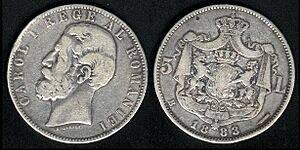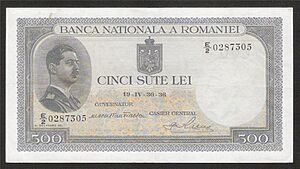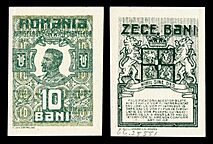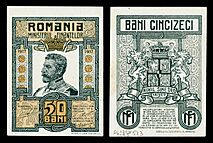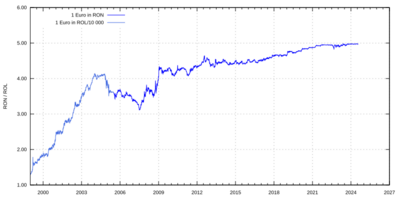Romanian leu facts for kids
Quick facts for kids Romanian leu |
|||||
|---|---|---|---|---|---|
|
|||||
| ISO 4217 Code | RON | ||||
| User(s) | |||||
| Inflation | Current value:6.6% (Q1 2024) | ||||
| Source | National Bank of Romania | ||||
| Subunit | |||||
| 1⁄100 | ban | ||||
| Plural | lei | ||||
| ban | bani | ||||
| Coins | |||||
| Freq. used | 10, 50 bani | ||||
| Rarely used | 1 ban, 5 bani | ||||
| Banknotes | |||||
| Freq. used | 1 leu, 5 lei, 10 lei, 50 lei, 100 lei, 200 lei | ||||
| Rarely used | 20 lei, 500 lei | ||||
| Printer | National Bank of Romania | ||||
The Romanian leu (pronounced "ley-oo", plural lei "ley") is the official money used in Romania. It's divided into 100 smaller units called bani (pronounced "bahn-yee"). The word "bani" also means "money" in the Romanian language.
Contents
What's in a Name?
The name of Romania's money, "leu," actually means "lion." This name comes from old Dutch coins called leeuwendaalder (pronounced "lay-oo-wen-dahl-der"), which means "lion thaler" or "lion dollar." These coins had a lion on them and were used a lot in Romania, Moldova, and Bulgaria. That's why the money in these countries is also named after the lion: the Romanian leu, the Moldovan leu, and the Bulgarian lev.
History of Romanian Money
The First Leu: 1867–1947
In 1860, Alexandru Ioan Cuza, a leader of Romania, tried to create a national currency. But his plan wasn't approved by the Ottoman Empire, which had influence over Romania at the time.
On April 22, 1867, Romania officially adopted a new currency system. The leu was set to be worth a certain amount of silver or gold. The very first leu coin was made in Romania in 1870.
For a while, foreign coins, especially Russian ones, were more common than Romanian ones. In 1889, Romania joined a group of countries called the Latin Monetary Union and decided to base its money on gold. This meant that silver coins were only used for smaller amounts. Foreign gold coins were also widely used, like French, Ottoman, Russian, and British ones.
During World War I, Romania stopped basing its money on gold, and the value of the leu dropped. Its value changed a lot over the years, especially during World War II. When the Soviet Union occupied Romania, their money (the ruble) was worth 100 lei. After the war, the leu lost a lot of its value, so much so that the National Bank had to issue a new leu, which was worth 20,000 old lei!
The Second Leu: 1947–1952
On August 15, 1947, Romania changed its money again in a process called the "Great Stabilization." This time, 20,000 old lei were replaced with just 1 new leu. People weren't warned about this change, and there were limits on how much old money they could exchange. This change mostly affected wealthier people. When it was first introduced, 150 new lei were equal to 1 US dollar.
The Third Leu: 1952–2005
On January 28, 1952, Romania introduced yet another new leu. This time, the exchange rates were different depending on how you held your money (cash, bank savings, etc.). Again, there was no warning.
Between 1970 and 1989, the government strictly controlled the leu's value. People were not allowed to buy or sell foreign money, and doing so could lead to prison time. This made it very hard for people to get foreign currency. This strict control, along with economic problems, led to shortages of goods, especially food. This was a big reason why people became unhappy with the government, which eventually led to the fall of the Communist regime in 1989.
After communism ended, Romania's money changed a lot. Banknotes started being made from special plastic instead of paper, and coins changed from aluminum to other metals. In the 1990s, the leu's value dropped quickly because of high inflation, sometimes as much as 300% a year! By 2003, one euro was worth over 40,000 lei. But after some good money policies, the situation became more stable by 2005.
For a short time in 2005, the Romanian leu was the least valuable currency unit in the world. However, Romania had even higher value banknotes in the past, like a 5,000,000 lei note issued in 1947.
The Fourth Leu: 2005–Present
  |
|
| 1,000,000 old lei 168 mm × 78 mm |
100 new lei 147 mm × 82 mm |
| Same design, different sizes. The images are to scale. | |
On July 1, 2005, the leu was changed again. This time, 10,000 "old" lei (ROL) became 1 "new" leu (RON). This made the leu's value feel more similar to other major Western currencies. This change was called "redenomination." It was a bit confusing at first for shoppers and cash machines. Old banknotes were still used until the end of 2006, but all bank accounts switched to the new currency on July 1, 2005. Stores had to show prices in both old and new money for a while.
Even today, some people still refer to amounts of new lei using the old values. For example, 100 new lei might be called "un milion" (one million) because it used to be 1,000,000 old lei.
Joining the Eurozone
Romania has been thinking about joining the Eurozone and using the euro as its currency. In 2014, they aimed to adopt the euro by January 1, 2019. However, by 2020, Romania hadn't met the economic requirements needed to join. In 2021, the Prime Minister said Romania might join in 2027 or 2028, but this date was later pushed back to 2029.
Coins of Romania
The size and materials of Romanian coins have changed many times throughout history.
First Leu Coins
In 1867, copper coins for 1, 2, 5, and 10 bani were made. Gold 20 lei coins were first minted in 1868. Later, silver coins for 50 bani, 1 leu, and 2 lei were added. Silver 5 lei coins came out in 1880.
In 1900, new coins made of cupronickel (a mix of copper and nickel) were introduced for 5, 10, and 20 bani. Some of these even had holes in them! Coin production stopped in 1914 because of World War I. It started again in 1921 with aluminum coins for 25 and 50 bani. More new coins were made in the 1920s and 1930s using different metals like nickel brass and silver.
By 1941 and 1942, zinc coins were introduced for 2, 5, and 20 lei, along with silver 200 and 500 lei coins. As inflation got worse after the war in 1946 and 1947, very high-value coins were made, including aluminum 500 lei, brass 2,000 and 10,000 lei, and silver 25,000 and 100,000 lei.
Second Leu Coins
After the 1947 revaluation, new coins were issued for 50 bani, 1, 2, and 5 lei. These coins showed King Michael I. But this series didn't last long because the king left power less than a year later. New coins were then made after the communist government took over in 1948. All second leu coins were stopped and lost their value in late 1952.
Third Leu Coins
In 1952, coins were first issued for 1, 3, 5, 10, 25, and 50 bani. These coins showed the state's symbol and the name "Republica Populară Romînă" (Romanian People's Republic).
In 1960, a new set of coins came out for 5, 15, and 25 bani, and 1 and 3 lei. These were made of nickel-plated steel. From 1966, the name on all coins changed to "Republica Socialistă România" (Socialist Republic of Romania) after Nicolae Ceaușescu became leader. However, older coins of these values were still valid. Later, the 5, 15, and 25 bani coins started being made of aluminum. These coins were used until 1991.
In 1991, after communism ended, a new series of coins with new designs and values was released. These included 1, 5, 10, 20, 50, and 100 lei. As inflation continued, these coins quickly lost value. So, new coins were introduced in 1998, including a 500 leu coin, and 1,000 and 5,000 leu coins in 2000.
Fourth Leu Coins
The coins used in Romania today were first introduced in 2005. They are:
- One ban: made of brass-plated steel.
- Five bani: made of copper-plated steel.
- Ten bani: made of nickel-plated steel.
- Fifty bani: made of nickel brass.
All these coins are still valid. There are also six special 50 bani coins that were made in 2010, 2011, 2012, 2014, 2015, and 2016 to celebrate different events.
The 1 ban coin used to be hard to find, but now it's more common. Stores often price things down to the exact ban, like 9.99 lei. For cash payments, many stores might round the total to the nearest 5 or 10 bani, but big supermarkets usually give exact change. When you pay with a card, the exact amount is always charged.
Banknotes of Romania
First Leu Banknotes
| 1917 fractional leu | ||
|---|---|---|
| 10 bani | 25 bani | 50 bani |
|
|
|
|
In 1877, the government started issuing banknotes for 5, 10, 20, 50, 100, and 500 lei. Later, the National Bank of Romania began printing its own banknotes in 1881 for 20, 100, and 1,000 lei.
During World War I, smaller value notes were reintroduced, and new high-value notes like 5,000 lei appeared in 1940. By 1947, due to extreme inflation, banknotes as high as 1,000,000 and 5,000,000 lei were printed!
Second Leu Banknotes
In 1947, after the currency revaluation, new banknotes were introduced. The Ministry of Finance issued 20 lei notes, and the National Bank of Romania issued 100, 500, and 1,000 lei notes. In 1949, a new bank, the Banca Republicii Populare Române, took over and issued 500 and 1,000 lei notes.
Third Leu Banknotes
In 1952, after another currency change, the Ministry of Finance issued notes for 1, 3, and 5 lei. The Banca Republicii Populare Române issued 10, 25, and 100 leu notes. In 1966, the Banca Națională a Republicii Socialiste România (National Bank of the Socialist Republic of Romania) took over all banknote production, issuing notes for 1, 3, 5, 10, 25, 50, and 100 lei.
In 1991, 500 and 1,000 leu notes were introduced, followed by even higher values like 200 and 5,000 lei in 1992, and up to 1,000,000 lei in 2003. There was even a special 2,000 lei note in 1999 to celebrate a total solar eclipse. The highest value notes were made of a special plastic material called polymer.
Before the 2005 revaluation, these were the banknotes in circulation:
- 10,000 lei (which became 1 new leu)
- 50,000 lei (which became RON 5 new lei)
- 100,000 lei (which became RON 10 new lei)
- 500,000 lei (which became RON 50 new lei)
- 1,000,000 lei (which became RON 100 new lei)
Fourth Series Banknotes
In 2005, new polymer banknotes were introduced for 1 leu, 5, 10, 50, 100, and RON 500 lei. In 2006, RON 200 notes were added. The designs of the 1, 5, 10, 50, and RON 100 lei notes are similar to the old high-value notes they replaced. The RON 10 note was updated in 2008 with new safety features.
The highest value coin in regular use is 50 bani. This means the 1 leu banknote (there is no 1 leu coin) is the smallest value banknote.
To prepare for Romania possibly joining the Eurozone, the fourth series banknotes are designed to be similar in size to Euro banknotes.
The RON 20 banknote was introduced by the National Bank of Romania in November 2021.
Current Banknotes
| Value | Image | Size | Main Colour | Description | Earlier Series in circulation |
Latest Series | |||
|---|---|---|---|---|---|---|---|---|---|
| Obverse | Reverse | Dimensions (millimetres) |
Euro equivalent | Obverse | Reverse | ||||
| 1 leu |  |
 |
120 × 62 | €5 | Green | Nicolae Iorga (a historian) and milkweed gentian (a flower) | Cathedral of Curtea de Argeș and the Wallachian Eagle | Series 2005 | Series 2018 |
| 5 lei |  |
 |
127 × 67 | €10 | Violet | George Enescu (a composer) and carnation (a flower) | Romanian Athenaeum (a concert hall) | ||
| 10 lei |  |
 |
133 × 72 | €20 | Pink and light red | Nicolae Grigorescu (a painter) and althaea (a flower) | Traditional house from Oltenia, Nicolae Grigorescu painting Rodica | Series 2005 Series 2008 |
|
| 20 lei |  |
 |
136 x 77 | None | Olive green | Ecaterina Teodoroiu (a World War I heroine) and crocus flavus (a flower) | Mausoleum of Mărășești (a war memorial), Victory as depicted on the Romanian Victory Medal | series 2021 | Series 2021 |
| 50 lei |  |
 |
140 × 77 | €50 | Yellow | Aurel Vlaicu (an aviation pioneer) and edelweiss (a flower) | A Vlaicu II airplane design, eagle head | Series 2005 | Series 2018 |
| 100 lei | 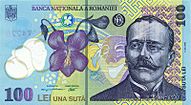 |
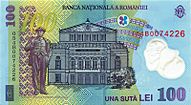 |
147 × 82 | €100 (ES1) | Blue | Ion Luca Caragiale (a playwright) and sweet violet (a flower) | National Theatre of Bucharest (old building), Statue of Ion Luca Caragiale | ||
| 200 lei | 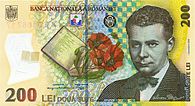 |
 |
150 × 82 | None | Brown and orange | Lucian Blaga (a philosopher) and poppies (flowers) | A watermill, The Hamangia Thinker (an ancient statue) | Series 2006 | |
| 500 lei | 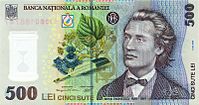 |
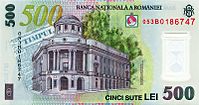 |
153 × 82 | €200 (ES1) | Gray and violet | Mihai Eminescu (a poet) and tilia (a linden tree) | Central University Library of Iași, Timpul (a newspaper) | Series 2005 | |
Exchange Rates
| Current RON exchange rates | |
|---|---|
| From Google Finance: | AUD CAD CHF EUR GBP HKD JPY USD TRY |
| From Yahoo! Finance: | AUD CAD CHF EUR GBP HKD JPY USD TRY |
| From XE.com: | AUD CAD CHF EUR GBP HKD JPY USD TRY |
| From OANDA: | AUD CAD CHF EUR GBP HKD JPY USD TRY |
| From fxtop.com: | AUD CAD CHF EUR GBP HKD JPY USD TRY |
See Also
 In Spanish: Leu rumano para niños
In Spanish: Leu rumano para niños
- Economy of Romania
- History of coins in Romania
- Banknotes of the Romanian leu
- Romania and the euro
- List of currencies in Europe




